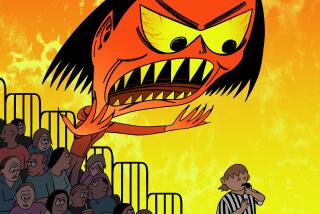Giving It the Ol’ Bronx Cheer
- Share via
It’s happened again. Two colleagues, a parent and a student have broken down in tears over the same issue. And because the issue is not a classroom problem but an extracurricular activity, I can’t help but be perplexed. Clearly, many of the concerns these people have expressed can be applied equally to school athletics, but their immediate experience has been with a spinoff of the sports program: cheerleading.
I have spoken with folks involved in cheerleading, both at my own school and others. Here are a few of their comments:
From a first-year advisor at one school: “I will quit teaching rather than be the cheerleader advisor again.”
From a former advisor: “Working with the cheerleaders came close to destroying my marriage.”
From a parent: “The whole cheerleading thing is sick, but it will never change.”
And from a cheerleader: “I had a nervous breakdown this year because of cheerleading.”
When we consider that extracurricular activities are supposed to enhance the high school experience and be fun, comments so emotionally charged need to be taken seriously.
It is important to restate that these are not isolated cases involving a few negative people. The advisors I spoke with obviously care about students and went into this activity with high hopes. The parent was equally concerned and loving in regard to her daughter. The student at one time looked forward to being on the cheerleading squad. So we have to wonder why things have gone so wrong.
Admittedly this involves a wide range of complex issues, many of which touch on the larger issue of high school athletics. Though I don’t pretend to be an expert in this area, I do see some obvious problems.
One reason emotions run so high is the fact that a lot of money is involved. It would seem that there should be some limit to the spiraling costs of being a cheerleader. Unbelievable as this may sound, it is not unusual for the annual bill to run as high as $2,500 for uniforms, competition entry fees and transportation. Because of the significant financial outlay, being a cheerleader is no longer even an option for many students.
Along with financial demands are other pressures. Not only do cheerleaders spend hours practicing, they devote additional time to raising money, making posters, even delivering cookies to male athletes the night before a game. Some squads also require gymnastics training on the students’ time. Such demands are bound to affect academic performance, but at many schools reasonable limits do not prevail.
Teachers, students, administrators and parents seem to agree that a major factor contributing to problems is the level of intensity that too many parents and extra coaches--who are not faculty members--bring to this arena. For whatever reason, be it the financial investment, the way in which team members are selected, ego gratification or self-esteem issues, the stakes have become too high, and there is simply too much emotional investment in this activity. In fact, several lawsuits have been filed in Orange County challenging school decisions on cheerleading policy.
(In one suit, a former squad member at Newport Harbor High complained that cheerleaders were charged nearly $7,000 for uniforms, transportation and other expenses. In another, a 16-year-old dismissed from the cheering squad for failing a chemistry class at Irvine’s Woodbridge High complained that an athlete would not have been dropped from a team for that reason--and won her case. A court sided with Irvine High School, however, when a student sued after being kicked off the squad for attending a dance instead of a cheering competition.)
*
If there is any hope that some degree of sanity will return, then a lot of parents and walk-on coaches will need to back off and put cheerleading into some sort of normal perspective.
Overriding all of this is a commonly held belief that the situation has gotten out of hand, that no one likes what’s happening, yet no one wants to be the first school to say, “Enough!” But when an activity is causing as much discord and pain as cheerleading, then we have a responsibility to see that such extracurricular endeavors are in step with the overall goals of the school.
If there are students crying in class, teachers crying in the faculty lounge and parents crying in the parking lot, something is seriously wrong. Surely, working together, school districts or athletic leagues can come up with some guidelines that can make cheerleading a more positive experience for everyone involved.
More to Read
Sign up for Essential California
The most important California stories and recommendations in your inbox every morning.
You may occasionally receive promotional content from the Los Angeles Times.













